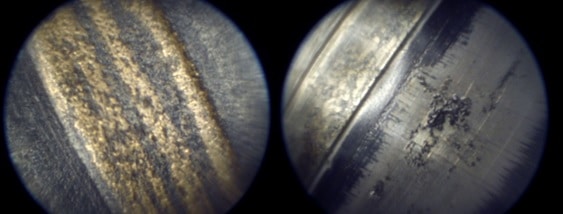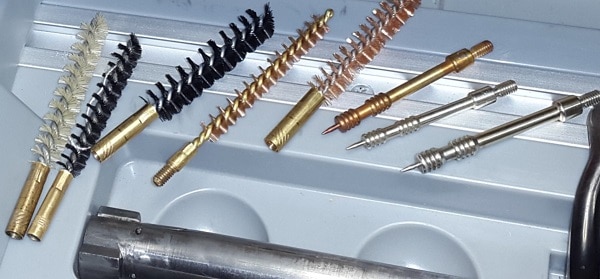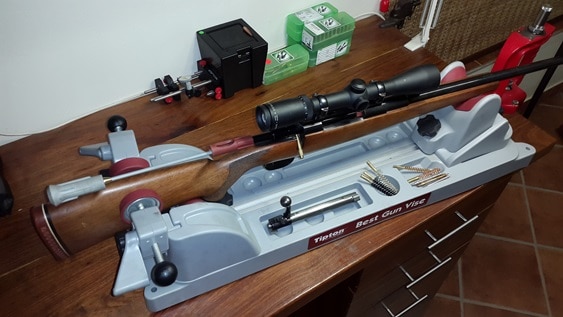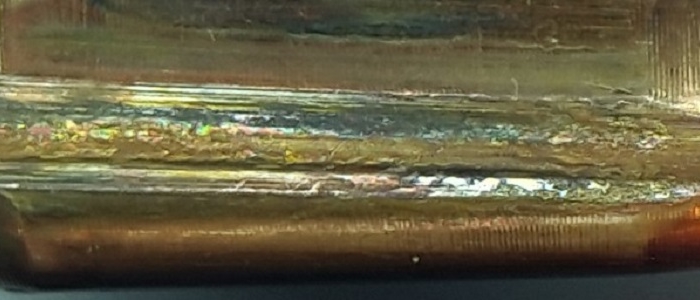
1. Benefits of shooting with a lubricated barrel after cleaning
Proper barrel preparation after cleaning is crucial for accuracy and extended barrel life. An unlubricated barrel, shooting an unlubricated bullet, equals massive friction, equals massive wear in the throat for the first few shots. This section is all about the different techniques that can be used to provide a good form of dry lubrication prior to the first shot. First shot lubrication will also help to get on the button and consistent shot placement from a cold, recently cleaned barrel.
When the first bullet is fired after proper cleaning, there will be no lubrication between bullet and barrel and this will accelerate barrel wear. In the long run it will also drastically reduce the barrel life. Modern gun powders contain lubricants that will only start to assist with lubrication “after” the first shot. This phenomenon was researched by the author and a simple experiment was used for analysis. The purpose of this experiment is to verify how effective propellant lubrication really is as well as the interaction of the first shots on a clean barrel.
A series of four unlubricated bullets with identical loads were shot with a two minute interval. The barrel was clean and bone dry. Each bullet was captured in a wax/paraffin mixture with the aim to preserve the barrel markings.

Shot 1 of 4: Heavy fouling on the lands
From the first shot it is clear that the lack of lubrication between bullet and barrel resulted in metal seizure between the lands and the bullet surface. The marks indicate considerable friction, heat and subsequent binding (fouling) of copper with the lands. The marks on the bullet suggest that unnecessary fouling deposits are laid down by the first shot. Premature copper deposits like this should be prevented and lubrication is the natural solution.

Shot 2 of 4: Less friction bonding, first signs of propellant lubrication.
After the second shot most of the damage is already done, however there is a clear reduction in the friction generated between the lands and the groove surface on the bullet. Black spots due to propellant lubrication start to appear randomly on the bullet bearing surface. A big shift in “point of impact” is apparent between shot one and shot two. A significant change in muzzle velocity was also recorded. This is highly undesirable for accurate shooting.

Shot 3 of 4: Healthy presence of propellant lubrication.
With shot number 3 the contribution of propellant lubrication is better established and a more uniform black coat is present on the bearing surface.

Shot 4 of 4: Good propellant lubrication. Near lubrication saturation reached.
With shot no 4 an equilibrium is almost reached. At this stage not much more lubrication can be deposited by the propellant for each successive shot onwards. Accuracy and muzzle velocity start to stabilize. As a side note: It is normal for this rifle to shoot smaller groups after the first 5 shots from a clean and unlubricated barrel.
It is clear that propellant lubrication play a significant role to prevent fouling. Unfortunately once the barrel is cleaned a few shots are needed for the propellant to establish enough of a lubricant buildup inside the barrel to be of any assistance. Therefore it is clear that pre-lubrication is required to effectively reduce/remove the trauma of the very first shot. The first line of defense is to pre-lubricate the barrel. The second line of defense is to lubricate the bullet. Since the main focus of this article is on barrel care and cleaning, only the merits of pre-lubrication methods for the barrel interior surface will be discussed.
2. Lubricants for internal barrel lubrication
Any form of lubrication may better than nothing but modern lubricants provide a solution for almost any application. Mineral oils provide non-contact lubrication due to the formation of a thin film to glide the one surface over the other. Unfortunately mineral oil film lubrication is of little benefit where direct contact is present such as barrel and bullet.
A better alternative is boundary lubricants that provide a protective, low friction surface regardless of extreme pressure and elevated temperature. Boundary lubricants are soapy solids deposited into and onto the microstructure of the parent metal with a more than 1 micron coating thickness. Typical examples of such lubricants are graphite, lead oxide, molybdenum disulfide (Moly), tungsten disulfide and boron nitrate. They can be applied “dry” as a powder or in a lithium grease base. A paste or grease made with boundary lubricants is the method of choice to apply lubrication inside the barrel. It is impractical to apply “dry” boundary lubricants to the barrel interior surfaces. With the help of a paste or grease solution the boundary elements can be rubbed into the sidewalls of the barrel with a patch on a copper brush.
Boundary lubricants such as “Moly” or boron nitrate in powder form are used with great success to coat bullets.
3. How to lubricate the internal barrel surface after cleaning
Step 1
Perform the barrel cleaning routine (See section about barrel cleaning). Finish off with a clean barrel and free from any solvents or lubricants.
Step 2
Make sure the rifle is set up in a cradle with a good quality bore guide fitted.
Step 3
Roll a patch on an undersized copper brush and smear the boundary lubricant grease liberally all over the patch. The patch should be quite tight fitting in the barrel. However, it must be possible to push the cleaning rod without bending or buckling when fully extended.
Step 4
Work the patch in short strokes from the throat to the crown for about six cycles in both directions. Pay special attention to the throat and first four inches of the barrel. Never allow the patch to protrude more than ¼ inch past the sharp edge of the crown. Always work with great care close to the crown with very slow strokes in this area, while ensuring that every square millimeter of the barrel surface is covered. It is very important that no lubricants get into contact or are deposited in the chamber.
WARNING: Solid lubricants are difficult to remove and if present in the chamber may lead to the transfer of dangerously high forces onto the bolt face.
Step 5
Remove the bore guide and remove any excess lubricant form the shoulder and throat area of the chamber. Clean the bore guide. Replace the bore guide again. Roll a new dry patch onto the undersized copper brush while ensuring that it is a tight fit. Work the full length of the barrel only once in short strokes. The purpose of the last patch is to find a balance between leaving as much as possible solid lubricants behind in a micro layer while removing all possible grease droplets.
4. Preserving a barrel for storage
Please note that this section is not about protecting the outer surfaces of a gun nor any wood or plastic parts. It is about keeping the bore of the barrel in good shape. Most of the time a rifle is actually in storage. So preserving a rifle should be almost a standard routine.
Never commit a barrel to short, medium or long term storage if it is not perfectly clean. Once the barrel is cleaned most of the hard work has already been done. While cleaning the barrel, always remember to flush out any copper removing solvents as they are corrosive by nature.
Do not allow any oil used for preservation to migrate to other parts of the rifle that may be damaged. Only a very light protective layer of oil is necessary. In other words after applying the oil in the barrel, follow up with a completely dry patch, it will not remove the protection layer, only the excess. More than enough oil will remain on the surface to protect the inside of a barrel for a long time.
A couple of independent tests have been done to evaluate the efficiency of lubricants and their ability to protect. Some of these tests were done in severe conditions which is unlikely to occur inside a gun safe. Most gun oils and even carbon removing solvents may be good enough to preserve a barrel till the next hunting season. An internet research turned up the following products as very useful rust inhibitors:
- Frog Lube (Also a good lubricant)
- WD-40 Special
- Hoppe’s Gun oil
- Barricade
- Rand CLP
- Break free
Try to stay away from rust protectors that will become gummy and tacky or is hard to remove. Most of the products in the list above will be very easy to remove from the barrel after a few months of storage.
Warning: Any lubricants that are not completely removed from the barrel is potentially dangerous. For safety reasons never fire a round through a barrel unless is free from any clogging or caking or droplets of preservation lubricant.
Related Articles
Introduction to Barrel Care and Cleaning
Good barrel cleaning habits may not be that obvious and can easily be contemplated as a dark art. This is the most important ritual after shooting and the sooner it is done the better. Good barrel care will not only improve you accuracy but it will also greatly improve the life of your barrel.
Barrel Care Part 1: How to know if a barrel is clean
What is a clean Barrel? It is a barrel free from any buildup of foreign material like gun powder residue or copper fouling in the grooves or anywhere on the lands. Every shooter has to know what the condition of the barrel is at any stage.
Barrel Care Part 2: What equipment to use for barrel cleaning
Setting up a proper cleaning kit can be costly. Some of the equipment is convenient and while others are essential. Settling on the right combination is largely a matter of personal preference. In this section all equipment will be discussed as well as their merits.
Barrel Care Part 3: How to clean a barrel
Developing the correct cleaning routine is a lot about common sense and a little about tradition. Due to many recent technological advancements and a huge variety of clean burning powders available today it will be wise to adopt modern gun cleaning practices.
Barrel Care Part 4: How to prepare a barrel before shooting
This section is all about the different techniques that can be used to provide a good form of dry lubrication prior to the first shot. First shot lubrication will also help to get on the button and consistent shot placement from a cold, recently cleaned barrel.





